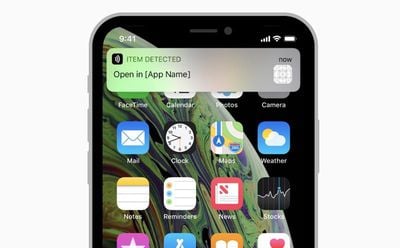As outlined on Apple's developer site, the iPhone XS, XS Max, and XR models allow users to scan NFC tags without an app using a new background tag reading feature.

On iPhones that support background tag reading, the system scans for and reads NFC data without requiring users to scan tags using an app. The system displays a pop-up notification each time it reads a new tag. After the user taps the notification, the system delivers the tag data to the appropriate app. If the iPhone is locked, the system prompts the user to unlock the phone before providing the tag data to the app.
Background tag reading is designed to work only when a user's iPhone is in use in order to avoid unintentional tag reading. It also will not work if a device has not been unlocked, a core NFC reader is in session, Apple Pay Wallet is in use, the camera is in use, or Airplane mode is enabled.
The new background tagging function will allow an iPhone user to scan any NFC tag at a museum, store, or other location without first having to open up an app. Scanning an NFC tag will present a notification on the display, which can be tapped to launch an app.
Launching an app using this method requires a tap from the user, so it will not allow NFC-based methods to automatically launch apps sans user permission.
According to Apple, background NFC tag reading is a feature that's limited to the iPhone XS, XS Max, and XR. It is not supported on iPhone X and earlier models.
























Top Rated Comments
NFC tags can be classified into two different categories. Active, and passive.
Active tags get battery inside and it will broadcast signals, just like these Bluetooth 4 SE beacons. It's easy to understand.
A passive NFC tag has no battery. It does not proactively transmit signals, and requires your phone to emit signals with specific defined frequency band and protocol. The internal circuit is "powered" by the electromagnetically inducted current and respond to the signal, but altering the antenna impedance of the tag. And the NFC reader scan for the reflected signal from the NFC tag. This is called "back-shattering".
The Apple Pay NFC is designed to interact with an active reader, not passive tag. So basically it's a simulated NFC tag device, not a reader device. The power transmission and antenna will hugely affect the shape of radio frequency radiation pattern and effective induction current. It need to be redesigned to fit the spec of passive tag scanner, not something that can be altered by software or some magic spells.
Because it's not a critical function. Basically there isn't any practical scenario in normal users' daily life that can only be done with NFC passive tag but not QR-codes.
Active NFC may be used in some scenarios like "touch-pairing" to setup peripheral devices. Sounds smart, but it's actually better doing that via Bluetooth. Active NFC modules is no cheaper then Bluetooth, and unlike Bluetooth, the frequency band of NFC is not entirely identical around the world. Which means you'll need to tweak the frequency for different markets. And sometimes this can not be easily done via software.
The NFC tag business is never mainstream by all means. It's not that cheap to be disposable, and it can not be attached to metal surface (the one that can fit metallic environment is extremely expensive). In industrial applications we would use reinforced tags embedded on road surface or shelves for autonomous navigation; apparently it's not some attractions for normal consumers.
Simply put: it's only a gimmick. Not very useful one.
Let me guess - it's because the software needs the 5 Billion operations/second Machine Learning chip new to these phones and in no way because Apple wants people to spend another $750+ on a phone.